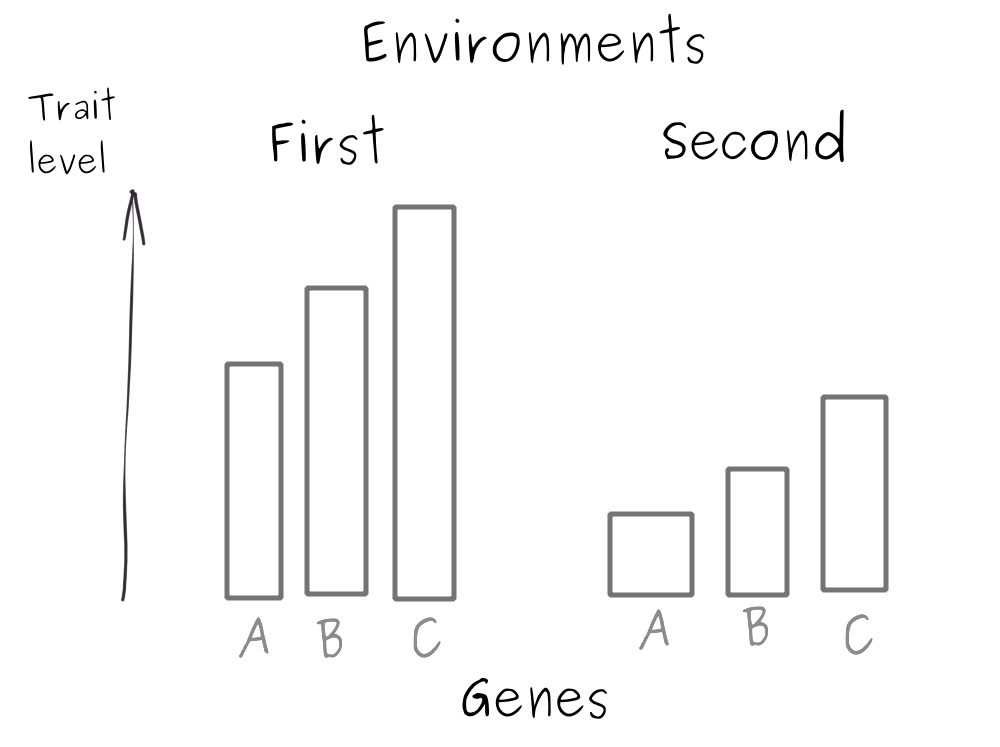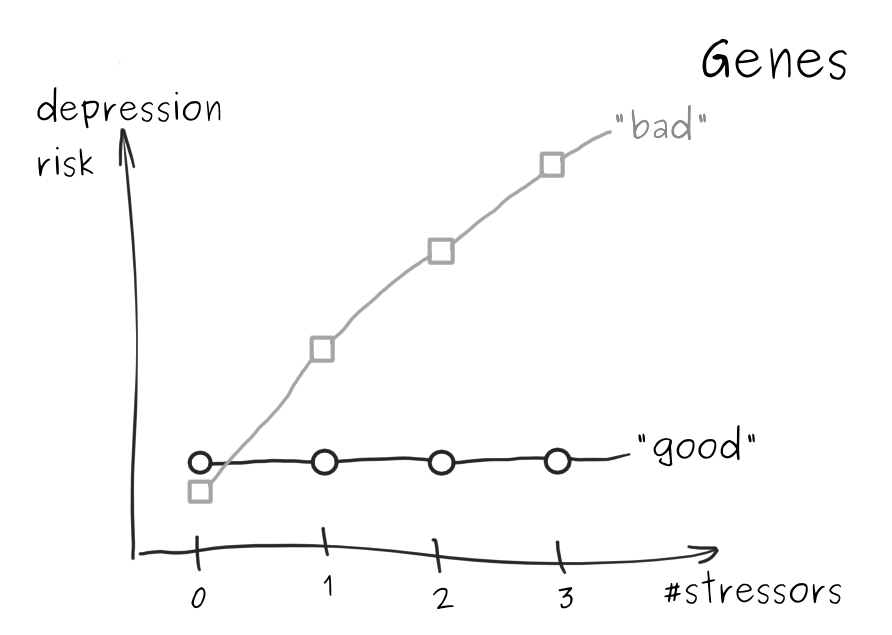"Human Behavioral Biology" - course summary (lecture 7)
Slowly (but steadily) going through the Sapolsky’s course. Lecture 7.
Lecture 7: Behavioral Genetics II
Genetic packages (metro dogs example)
Another example similar to the domesticated Siberian foxes case is metro dogs in Russia. They are effectively selected for avoiding humans, being in packs and aggressive temperament. As a result, they start looking like wolves very fast (e.g. tail shape). This appearance is not needed for their survival, but it comes as one genetic package.
Behavioral genetics approaches
Modern version of behavioral genetics tries to find a gene for something. In the classic version, a phenotype was considered and then individual genes were compared in individuals, which have different phenotype trait (e.g. eye color), i.e. something external. Alternatively one can look at proteins and how they function (i.e. an intermediate step between genes and traits). Finally one can investigate differences of protein sizes (without knowing the precise function). However, this works only in “simpler” cases, like looking for a gene for a specific disease like PKU, cystic fibrosis (but not TV taste). Now find a family where approximately half has the disease. Find a segment of DNA which everyone with the disease has, but no one without. This usually gives you a stretch of DNA consisting of 10-30 genes. Somewhere in this sequence there is “the gene”.
Challenges
- One must be very certain in the conclusions before claiming anything (e.g. ways to detect diseases can be used to decide whether to abort pregnancies).
- Bio ethics - there is a very low statistical chance that you’ve got a wrong marker. Should people get tested for the disease using these markers anyway?
- Finding “the gene” - most diseases are not caused by one gene. There are ways to find multiple genes, e.g. gene microarrays (which involves forcing a cell to produce all RNA it has and then gluing it on a chip, keyword: QTL).
Starting with gene
Another approach is to start from a gene and to study it across species. E.g. you have 2 different versions of a gene and try to see differences in behavior, protein function or size.
Issue - this way you look only where “the light is shining”.
Examples:
- vasopressin hormone - in rodents (vole) its receptor defines whether an individual is monogamous or polygamous. The difference is in promoter. After discovering this, one can ask whether this holds for people and try to see the differences. It does actually hold - if you have the monogamous promoter - more stable relationships. How good one at reading faces also depends on this. Families with autism have mutations in vasopressin receptor.
- BNDF protein - prompts growing new neurons. In rats causes creation of new connections in amygdala and impacts anxiety levels. There are different versions of it. You can study this in rats and then in people (this has been done). In humans the type of this protein identifies likelihood of anxiety disorder and level of stress hormones in blood.
- Dopamine (DF4 in rodents) - defines levels of risk-taking behavior in humans (novelty seeking).
- NPY - differences of levels of anxiety in humans.
However, all of these explain only a small portion of overall variability.
Role of random events (chance)
Brownian motion - intrinsic movements of molecules (completely random).
Mitochondria has their own DNA and there can be different mitochondria DNA in one cell (mitochondria divides on its own). When a cell splits, the resulting set of mitochondria DNA in each daughter is random (based on position of mitochondria in the cell during the split). The same is true for transcription factors and splicing enzymes.
As a result, it is not “Nature + Nurture”, but “Nature + Nurture + Chance”.
Heritability
All such studies result in some statement like “this trait has 53% heritability”. The meaning of this is often misunderstood.
Heritability does not tell how genes affect average value of a given trait, but instead the degree of variability around the average. E.g. imagine a trait with values 9, 10, 11 and another trait with values 1, 10, 19. In both cases the average is 10, but the variability is larger in the second case. In this example heritability does not tell how much genes determine the average value 10, but variability instead.
Another example - imagine a plant with 3 versions of a gene (A, B and C) defining how well it retains water. There is a difference of this trait across A, B and C (i.e. this gene has good predictive power). At the same time environment affects it much more, thus, heritability is actually low.

If you happen to study only one environment, it will look like genes are much more important than they actually are. Unfortunately, that’s how science mostly works (take one species like some dessert rat and study it, i.e. control for environment). This removes ability to see the role of environment.
Random peculiar fact - how to measure protein size - put them somewhere where they move as a function of their size and measure difference in position (e.g. sinking in a gel).
In other words, if you had to predict trait level - would you choose environment or genes?
Humans inhabit a lot of environments. There are gene-environment interactions, which can change gene effect.
Studying only one environment inflates heritability.
More examples.
-
Heritability of number of fingers in humans. Genes define “5”, but not variability. The variability is e.g. due to industrial incidents. Thus, 0% heritability.
-
Men with earing in 1950 were rare, but almost all women had earrings. The variability is caused by gender, thus, 100% heritability (if you had to guess, you would love to know individual’s gender).
Environment is important
Examples where environment plays crucial role in the outcome:
- PKU is related to a disorder, when toxic phenylaline cannot be turned into a safer thing inside the body. To predict the disease, would you like to know where the person lives or whether there is a mutation in the enzyme? Obviously, mutation, 100% heritability. But the disease highly depends on food. One can avoid certain foods and don’t be affected by the disease.
-
Consider another gene, which is related to depression. There are 2 versions - “good” and “bad”, which affect how prone to depression one is. However, this also depends on number of major childhood stressors they had (divorce, loss of parent). What do these genes do? It depends on your environment. If you have no stressors, then the “bad” version actually makes you less prone to depressions (the study observed tiny differences).

The number of stressors actually defines level of stress hormones.
-
There is a gene, which affects predisposition to aggression. The graph is the same as above, but the horizontal axis is “child abuse”.
-
FAD2 - predicts IQ abilities and is involved in carbohydrates metabolism. The environment in this case is “breast feeding”. I.e. it predicts IQ abilities, if you have a diet high in carbohydrates very early in life.
- On average men are better at math than women. However, is this genetic? When studied all over the world, the greater the gender inequality was, the larger was the difference in math scores. It is not a function of gender, but the society type. In Iceland (smallest gender inequality) girls are even slightly better at math than boys. If we wanted to guess, we would rather known whether they are from Tunisia or Iceland. Even when considering top 1%, this is still not much about genes (in the US in 1950 the ratio was 13 boys to 1 girl, nowadays - 3 to 1).
The more environments you study, the lower heritability is going to be. We are giving more opportunities to say “it depends”. As a result, it is meaningless to ask “what does this gene do?”, instead it should be “what does this gene do in this particular environment?”.
Single genes define a lot for flies. Even when you see a gene for X, is it just an indirect effect (like height causing being an extrovert)?